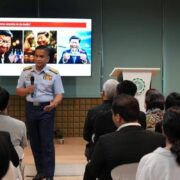Double whammy for PH eco warriors

Once again, the Philippines has earned the title and disgrace of being Asia’s most dangerous hotspot for environmental defenders, based on the latest report of the international watchdog Global Witness.
But “once again” is putting it lightly, for the country has actually received the dubious honor for the 11th year in a row, a troubling sign of the government’s lack of resolve to protect the brave few who are fighting for land and environmental rights in this part of the world.
According to the Sept. 10 report, “Missing Voices,” the Philippines logged the highest number of green activists killed across the continent from 2012 to 2023. Last year alone, some 17 land and environmental rights defenders were slain in the country, half of them small-scale farmers.
Globally, the Philippines ranked fifth on the list topped by Colombia, with 79 deaths, followed by Brazil, with 25, and Honduras and Mexico, with 18 each. By chance, the annual Global Watch report came just on the same day the fugitive former governor Joel Reyes of Palawan, wanted for the Jan. 24, 2011 murder of broadcaster and environmentalist Gerry Ortega, surrendered to the authorities in hospital on Sept. 10.
Precarious situation
The brutal murder of Ortega, a prominent voice against mining in his island province, grabbed headlines more than a decade ago and continues to be closely watched as a test case in the fight against impunity and environmental rights abuse in the Philippines.
But wretched as it is, his case is not unique.
In 2010, the country’s top botanist, Dr. Leonard Co, along with two aides, was killed by the military after they were mistaken as rebels during a combat operation in Kananga, Leyte, an incident the Commission on Human Rights said “illustrates the precarious situation of environmentalists in rural areas where armed conflicts occur.”
In its report, Global Witness said a total of 468 environmental defenders were killed across Asia between 2012 and 2023. Almost two-thirds of them—or 298— were in the Philippines.
But attacks on environmental defenders are not limited to the use of deadly force. “Nonlethal attacks are also increasingly used as tactics to suppress activism across the region,” the report noted.
Enforced disappearances
In Asia, a total 1,033 violations of this nature were reported within the study period, including seven enforced disappearances in the Philippines. Two of them were the activists Jhed Tamano and Jonila Castro, who were “violently abducted” by armed men in September 2023.
After 17 days, the pair appeared at a press conference arranged by the government’s anticommunist task force in Bulacan, where they were expected to renounce their purported affiliation with rebel groups. Instead, they courageously exposed their ordeal at the hands of the military.
“This trend is part of the tactics used by authorities to intimidate people into silence,” Global Watch said. In its 2023 report encompassing the previous year, the watchdog said President Marcos, since coming into power, “has so far failed” to address human rights violations. “Instead, he has focused his agenda on business and economic interests, raising continued concerns amongst civil society about an increase in mining and other resource exploitation at the cost of human rights and the safety of defenders,” it said.
To be fair, the President has often emphasized the vulnerability of the country to the impact of climate change and the need to build resilience among the people. “As we can see in all the world, weather events are … getting more extreme such as torrential rains that instantly shift to scorching heat waves or vice versa,” Mr. Marcos said during his third State of the Nation Address last July.
Lamentably silent
But the President was lamentably silent on the risks faced by environmental crusaders working tirelessly to help communities weather the brunt of climate change, the destruction of natural resources, and the social, cultural, and economic consequences that come with it.
Colombia, the No. 1 deadliest country for environmental defenders on the Global Witness list, had been quick to issue a statement recognizing the “serious situation that is derived from socio-ecological conflicts associated with drug trafficking, extractavist practices connected to illicit economies, and the reconfiguration of the armed conflict.”
Alas, there was not a word from Philippine officials, their heads buried stubbornly in the sand.
It’s ironic that despite the escalating danger from natural and human disasters in these parts, the biggest threats facing green warriors are the same as ever: moneyed interests and an indifferent government.
What a shame, and doubly so, because last week, at around the time the Global Watch list was published, came another study, the 2024 World Risk Report, which—for the third year in succession—placed the Philippines first among 193 countries in terms of disaster risk from extreme natural events and negative climate change impacts.

















